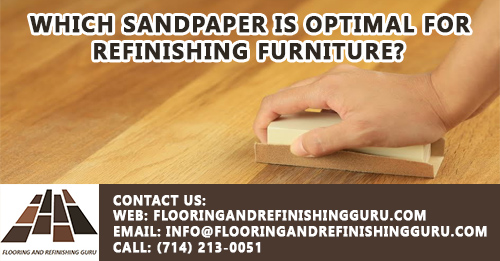
Sanding is one of the most important steps in the refinishing process. Sandpaper, a key tool in repairing wooden surfaces, offers grits of different types, such as coarse, fine, medium, etc. Sanding is one of the most important steps in the Refinishing Furniture. Sandpaper, a key tool in repairing wooden surfaces. An expert understands the utility and functionality of a sandpaper, especially when dealing with various flooring surfaces.
Let’s discuss some grit sizes for your convenience!
-
40-80 Grit
This grit type is used for rough or heavy sanding to eradicate imperfections like scratches or blemishes. Moreover, it is used on thick-coated surfaces of paint or stain. It is labeled as a ‘coarse-grit sandpaper’ by experts. Besides smoothening surfaces, it can also be used to create textured surfaces.
-
100-150 Grit
Medium-grit sandpaper provides a smooth/rough finishing to wooden and about-to-be-painted surfaces. After the process, the layer offers minimal tooth and texture. 100-150 grit emery/garnet papers are beneficial for drywall sanding, when used with an orbital sander, and hand-sanding.
Read More
Which Type of Vinyl Flooring is Most Durable?
Which is Better? LVT or Laminate Flooring?
Which Floor Tiles are Best for Living Rooms?
-
180-220 Grit
Also classified as fine-grit sandpaper, it is mostly used in the finishing process or sand-in-between coats. This surface-enhancer is excellent for removing scratches from low-grit papers. It is used to scuff polyurethane, sand lacquer, and other finishes.
-
320-400 Grit
Extra-fine grit is used to polish surfaces after the staining process. In addition, it is applicable on hard surfaces, such as metal. Water-based paints raise the wood grain and make it appear coarse: 320-400 grit sandpaper helps to sand down the fibers.
-
Other Grits
Following are some of the other-known sandpapers used for smoothening surfaces:
- 16-36 Grit (Extra-Coarse)
- 400-600 Grit (Super-Fine)
- 800-1000 Grit (Ultra-Fine)
Read More
Which is the Most Popular Flooring in Homes Today?
What is the Difference Between Luxury Vinyl Planks?
Buying Guide for Timber Floor Finishing
Types of Abrasives
- Aluminum oxide: It is used to smoothen metal and hardwood surfaces.
- Emery: This paper is applied on metallic surfaces. It is not preferable for wooden surfaces.
- Garnet: It is used for fine-sanding layers. It is softer than emery paper.
- Silicon Carbide: This paper is optimal for sanding materials, such as plastic, metal, softwood,
and hardwood.
Types of Wood & Sanding Grits
| Material | Sanding (1st) | Sanding (2nd) | Sanding (3rd) |
| Walnut | 150 | 180 | 220 |
| Fir | 120 | 150 | 180 |
| Pine | 120 | 150 | 220 |
| Maple | 120 | 120 | 180 |
| Birch | 120 | 150 | 180 |
| Oak | 120 | 150 | 180 |
| White Ash | 100 | 150 | 180 |
| Cherry | 120 | 150 | 220 |
Pointers for Sanding Surfaces
Before commencing the sanding process, its essential to understand the surface you’ll be working on. Analyze the top layer for scratches or any other marks; this would help select the right type of sandpaper. Secondly, the surface material (wood, metal, etc.) also plays a huge role in determining the grit number.
Surfaces should be free from particulates. Generally, unfinished or raw wood requires coarse-grit sandpaper while smoother surfaces need finer grits. Opt for more sanding on end-grain areas to avoid stain absorption.
To manage stain color, you need to opt for the right type of grit paper. Low-grit ones are applied for darker stains, while high-grit ones are used for lighter tones.
Most tasks involve a systematic progression from coarser to finer grits, called ‘going through the grits’. Rough sanding is applied to remove stripper or finish residue; 80 or 100-grit sandpaper is optimal in this regard. 100-120 grit smoothens the surface imperfections and higher grits prepare the surface for finishing.
To get a smooth finish, sand the surface lightly. Wet sanding produces a glass-like appearance that can be buffed with wax or polishing compound.
Conclusion
‘No sanding, no finishing’ is the term applied by experts when converting a rough surface into a smooth one. Connect with a reliable firm, such as Flooring and Refinishing Guru for time-oriented and optimum results.

